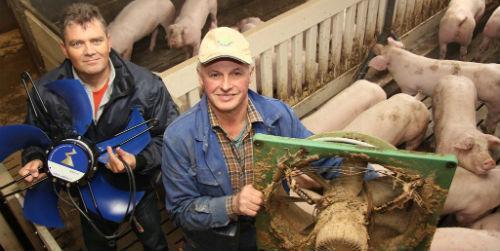An example of the use of EC motors for ventilation in a space that needs optimal conditions for its operation.
example of the use of EC motors for ventilation in a space that needs optimal conditions for its operation.
by Ziehl-Abegg
Paul Neff, rancher: "We need something safe, not a cheap fan."
With a monthly electricity bill of 2,000 euros, Paul Neff pays close attention to how much current each piece of power each piece of equipment consumes and where it does so. This farmer from Hohenlohe, Germany, manages a 100-hectare farm with 1,600 fattening animals and 1,500 piglets of which 300 breeding sows are taken care of. In 1998, his business was the first worldwide in which cost-effective EC motors were used to power fans.
The previous history
In 1997, Gerhard Leutwein was exposing to visitors to the EuroTier livestock fair in Hannover at the Ziehl-Abegg stand everything related to motors and fans, when suddenly he heard a familiar dialect: Paul Neff wanted to find out how he could actively ventilate his new barn with the minimum possible use of energy.
After two sentences it was clear: both lived less than 10 kilometers apart, the conversation became more personal and pleasant. Neff still remembers very well how he joked with the head of development: "You have to make fans that generate current from behind!" Leutwein took the bait and informed him that just Ziehl-Abegg had just developed a new engine with extremely low fuel consumption.
Since the early 90s, the Künzelsau motor and fan manufacturer has already used EC motors in the new digital switchboards for mail and telephony. In these EC motors, the electronic control and power system was still placed separately. Now the developers had an engine up their sleeve, in which the electronic system was directly behind the engine. All tests came back positive. The combination of an EC motor and a modern fan, called "ETAvent", managed to provide service safely and quietly in spaces with livestock.
Eight cameras in the new barn would be installed by farmer Neff for long-term comparative testing of the fans: conventional AC motors were installed in four chambers, while new EC motors were installed in the other four. Each engine had its own separate measuring equipment. Neff always communicated the results of the measurements to Ziehl-Abegg by telephone. Hence, you can still remember the results very well: "Fans with the most advanced motors consumed only 43% of the current that was previously needed under the same conditions." If calculated over the course of a year, the savings are 80%. This shows that investment in EC motors recovers quickly, although their acquisition price is significantly higher than that of AC motors.
Engines in use all year round
The fans of the farmer Neff work all year round. Depending on the outside temperature and the occupation of the barn, more or less power is needed. Of the eight ventilators, five have been in constant operation for 18 years without giving any problems. Over the course of that time, the bearing on three of them only had to be changed once. "In the old barn I also have fans that have worked 40 years in a row without having replaced the bearing," says Neff.
The Füßbach estate houses 300 breeding sows, as well as 1,600 fattening animals and 1,500 piglets. It is of great importance that all stables maintain a stable temperature. The Ziehl-Abegg regulation equipment in the corridors controls the camera fans, so that the expected temperature is always maintained regardless of weather conditions and the number of animals. For the farmer Neff reliability is something inalienable, so he bets on products of the brand: "We need something safe, not a cheap fan," he said when relying on Ziehl-Abegg fans, since for him, using unreliable equipment could harm animals, and it is something that can be allowed.
With 18 years in uninterrupted operation on a pig farm and has only damaged the aesthetics in this Ziehl-Abegg fan: the motor and its integrated electronic system still work without problems. Now they are about to reach the fan stables even more efficient and silent.














